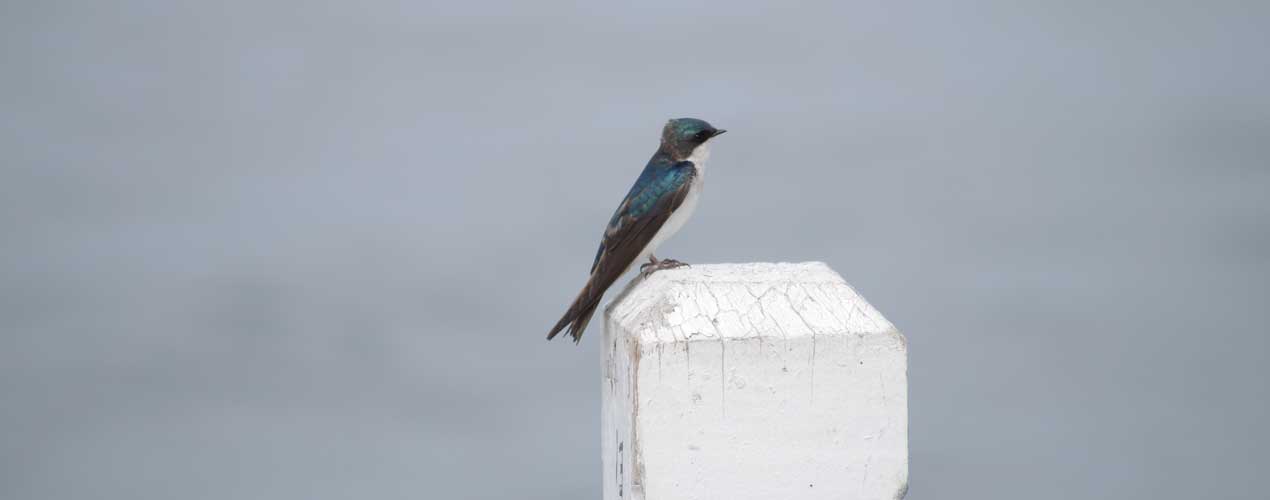VOF Resolution Recognizing International Migratory Bird Day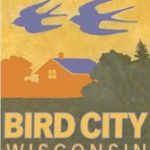
International Migratory Bird Day Event Program
Village of Fontana Renewal Application
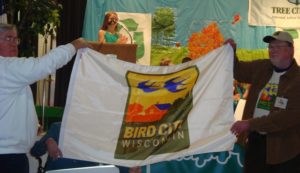
Past Village President Arvid Petersen received the Village’s Bird City Wisconsin flag from Program Coordinator Carl Schwartz at the Village’s inaugural IMBD program at Fontana Elementary School Friday, April 27, 2012.
_______________________________________________________________________
CREATING A BACKYARD BIRD HABITAT
Birds Need Food, Water, Shelter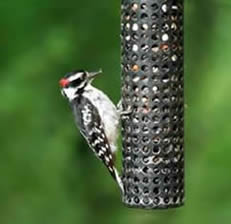
Creating a backyard bird habitat can be as easy as setting up a bird feeder or as complex as landscaping with native plants, flowers and grasses. Birds need three things to thrive –food, water and shelter. By providing all three in your yard, you’ll likely attract dozens of species throughout the year. Birds love variety, so set out several feeders with different kinds of food, and place shallow pans of water in various locations to get their attention. Build your own birdhouses to encourage birds to return to your yard every season. Attracting birds to your backyard is both simple and inexpensive, with immeasurable benefit to both you and wildlife.
Feeders
-
- Different feeder styles and foods attract different species of birds. According to the Cornell Lab of Ornithology, the first step in setting up feeders is to decide which birds you want to bring into your backyard. Use a bird field guide to discover the birds in your area of the country and what foods they like, then erect feeders to attract them. The most effective styles for seed are tray/platform, hopper, window and tube feeders, while wire-cage feeders work best with suet. Nectar feeders will attract hummingbirds, orioles and fruit-loving birds. To attract the greatest number of species, choose several styles and scatter them throughout your backyard.
Water
-
- Water is a necessity for attracting birds. Give birds a clean source of water with a shallow birdbath set low to the ground, rather than on a pedestal, to mimic a puddle or pond. Place gravel or clean sand in the bottom for substrate, and lay a few branches over the bath to let birds drink without getting wet. Empty and replace the water every other day to prevent mosquitoes, algae or contamination. Clean the bath with a scrub brush if dirt or bird droppings begin to accumulate.
Nest Boxes and Materials
-
- Birds are likely to return to your yard every season if you give them plenty of nesting materials and boxes. Follow guidelines (available online from the Cornell Lab of Ornithology) for building your own nest boxes to attract specific species and keep out others. Woodpeckers, chickadees, nuthatches, wrens, bluebirds, owls and some ducks are cavity nesters and will readily set up house in a homemade nest box. Robins, swallows, flycatchers and doves prefer to nest on a semi-enclosed platform. For species that simply nest in trees, put out a selection of nesting material like dried grass, twigs, yarn and bits of cotton batting. Be sure to place the nest boxes in the appropriate settings and clean them thoroughly every season to keep them in good shape.
Brush and Ground Cover
-
- Backyard birds appreciate a safe haven to escape predators, such as dense brush, shrubs or trees. Encourage birds to visit by maintaining a wildlife-friendly yard. Keep a brush pile in a corner of your property. Start one with your old Christmas tree and set feeders nearby. Keep native trees or shrubbery on your property to maintain the natural landscape of your region of the country, and leave fallen trees, branches or wild plants on the ground rather than removing them.
Landscaping
-
- Landscaping to attract birds requires planning, but can result in an optimum environment for dozens of species all year long. Plant a variety of native plants and trees. Not only will you diversify the natural offerings to birds, but also reduce the amount of upkeep you’ll need to perform. Native plants usually require less watering or pesticides than ornamental or non-native species. Choose deciduous and coniferous plants that bloom in all seasons, especially those that provide food like seeds, fruit or nuts. Plan a dense thicket with dead wood, climbing vines or hedge. Scatter wildflower seeds over beds on your property to beautify your yard and grow a feast of seeds for birds.
LINKS FOR INFORMATION ON BACKYARD HABITAT PROGRAMS
Backyard Wildlife Habitat Program: Whether you have an apartment balcony or a 20-acre farm, you can create a garden that attracts beautiful wildlife and helps restore habitat in commercial and residential areas. By providing food, water, cover and a place for wildlife to raise their young — and by incorporating sustainable gardening practices. www.nwf.org/backyard
Wild About Gardening: This website is all about gardening for wildlife. It offers a huge amount of information for both novice and expert gardeners alike. You’ll learn how to plan your garden to meet both your needs and that of the wildlife you wish to attract. It is full of tips on attracting all sorts of wildlife from butterflies and birds to bats and frogs. You’ll find lists of plants and the wildlife they attract, scores of planting projects, plans for building bird nesting boxes, amphibian ponds, and many other structures, plus guidelines on how to discourage some species from making pests of themselves in your yard. www.wildaboutgardening.org
Natural Resources Conservation Services: Information on Backyard Conservation and Wildlife Habitat techniques. https://www.nrcs.usda.gov/wps/portal/nrcs/detail/national/newsroom/features/?cid=nrcs143_023574
LINKS FOR INFORMATION ON REMOVING BIRD HAZARDS
American Bird Conservancy: Cats Indoors! The Campaign for Safer Birds and Cats, was initiated by the American Bird Conservancy (ABC) to end the unnecessary suffering and death of birds and other wildlife caused by free-roaming domestic cats. Cats Indoors! seeks to educate cat owners, decision makers and the general public that free-roaming cats pose a significant risk to birds and other wildlife, suffer themselves, and pose a threat to human health. www.abcbirds.org/abcprograms/policy/cats/index.html
Wisconsin Bird Conservation Initiative: The effects of free-ranging cats on birds in Wisconsin: Wisconsin Bird Conservation Initiative Issues and Guidelines. www.wisconsinbirds.org/CatsBirds.htm
NINE METHODS TO HELP BIRDS AVOID WINDOW COLLISIONS
Birds of many types have been killed by flying into glass windows and doors. According to the Audubon Society, collisions with glass may be a major source of avian mortality that’s widely overlooked.
Although there are several variables which account for bird strikes, the primary cause is reflection. Birds become confused or startled and rush to cover or open sky; unfortunately they often mistake a reflection for the real thing.
In cities the biggest kills typically occur at night during spring and fall migrations, when building lights appeared to lure birds into deadly collisions. Light-dimming campaigns, such as those led by the Toronto-based Fatal Light Awareness Program, have helped reduce the problem.
Following are 9 ways to reduce bird strike occurrences in homes and small buildings:
1. Observation – Bird strikes often follow a pattern – the same windows on a house or building may be repeatedly struck, while others are never struck. Observation and attention to bird attractions such as water, food and cover, will help identify the small percentage of glass area in your home which causes the most problem.
2. Block ‘through-house’ line of sight to the outdoors – Are any windows in your home oriented such that, from the outside, there is a clear view through the house and to another window looking to the outside? A bird may see this as a flight path. This can be changed simply by putting up a shade on the one window, or closing a door or similar obstruction which breaks the open view.
3. Reduce window reflection – Birds often strike windows because they see a reflection of clouds, sky or trees which gives the mistaken impression that they are flying into open air. Put a screen or a shade cloth over the window which is nearest to bird activity. A shade cloth, available at hardware stores, is a plastic mesh that allows you to see through, yet keeps the windows from having reflections. If you have blinds, turn them so they are slightly closed, this will reduce reflection. White shears also work to reduce reflection while being able to see through.
4. Window decals – Many different window decals are on the market for applying to your window for bird strike prevention. These commonly come in the outline form of a hawk silhouette or spider web. While these may be effective, it is difficult to judge if they make a difference in reducing strikes. Birds may not be deterred by stationery objects such as decals.
5. Place a hawk silhouette on your window – Most smaller birds will avoid the company of hawks, especially the sharp-shinned hawk which flies low into cover, often near feeders, and preys on small birds. A hawk simulation can be placed on your window or glass door to discourage birds from flying in this direction. The key is to hang this on the outside of the window, using a suction cup with a bit of clear fishing line to hang the silhouette so it swings in the wind.
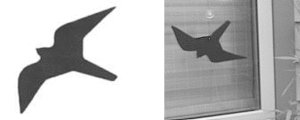
You can make a life-sized hawk silhouette by copying the image here, and scaling it up to an 11-inch wingspan. Trace the image onto a piece of corplast (available in building supply stores) or similar black plastic, and cut it out with a razor knife. Use fish line and suction cup to suspend from the outside of the window. Hanging a plastic owl is not effective over time, as the figure never moves and birds quickly learn to ignore it.
6. Tack up a temporary cover – Sometimes a more aggressive behavior occurs, typically in the breeding season, where a bird repeatedly ‘attacks’ a window. Seeing its own refection as another bird, it’s trying to drive it away, as songbirds are competitive during breeding times. A cloth, piece of netting or solid material can be placed on the outside of the window for a few days to break the bird of its habit. Or you can install indoor-outdoor blinds on the outside of the window.
7. Place sun ornament, crystal or other objects in your window – Sun ornaments, crystals, strips of cloth and other objects in the window will help birds know they can’t fly through. Avoid hanging plants in front of windows which are in areas of high bird activity – this can further confuse the bird which may fly towards the plant looking for shelter. Double-pane windows have enhanced reflection and are harder for a bird to see through.
8. Locate prey and food attractants away from windows – During spring and summer, bright flowers on the inside windowsill can attract hummingbirds. Hummingbirds usually approach quickly, then hover, before putting their beak into the flower. If the flower is right against the window, the bird will likely stop in time. But if the flower is set back 6-to-12-inches from the window, an accidental strike may occur.
9. Locate bird feeders adjacent to, or further away from windows – Bird feeders should be positioned either further back in the yard or up close within 2 or 3 feet of a window. By placing the feeder up close, birds come in at a slower speed; they’re less likely to get hurt during escape because window strikes occur at slower speed. By placing the feeder further out (10 feet or more), the bird has more room to maneuver. Cats are usually wise to the presence of birds around feeders, and the bird needs space to escape in any direction. Locating the feeder in the 3-to–10-foot zone from the window may result in more window strikes. Window mounted bird feeders do not encourage bird window strikes.
If you find a bird stunned by a window collision, never handle the bird, or any other wild animal, with your bare hands. Often when a bird collides with a window, it is just stunned and will be flying again within an hour, after regaining its senses. With gloved hands, carefully pick up the bird and place it in a safe area away from cats and other predators. In cool weather, place the bird in a well-ventilated box in a warm area to recover. Avoid handling the bird and the box as much as possible.

